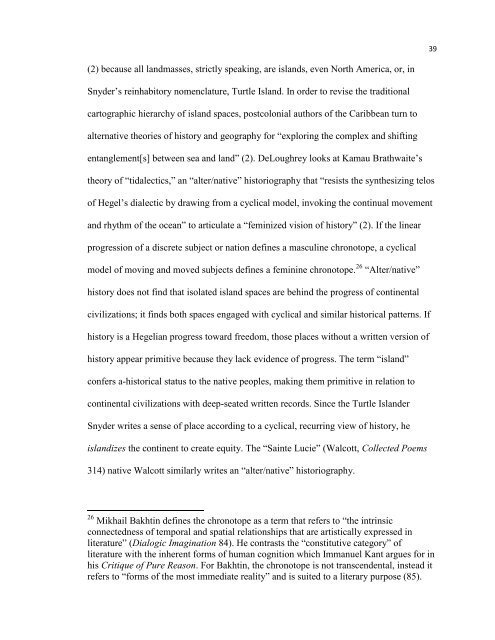RE-INHABITING THE ISLANDS - The University of North Carolina at ...
RE-INHABITING THE ISLANDS - The University of North Carolina at ...
RE-INHABITING THE ISLANDS - The University of North Carolina at ...
You also want an ePaper? Increase the reach of your titles
YUMPU automatically turns print PDFs into web optimized ePapers that Google loves.
39<br />
(2) because all landmasses, strictly speaking, are islands, even <strong>North</strong> America, or, in<br />
Snyder‘s reinhabitory nomencl<strong>at</strong>ure, Turtle Island. In order to revise the traditional<br />
cartographic hierarchy <strong>of</strong> island spaces, postcolonial authors <strong>of</strong> the Caribbean turn to<br />
altern<strong>at</strong>ive theories <strong>of</strong> history and geography for ―exploring the complex and shifting<br />
entanglement[s] between sea and land‖ (2). DeLoughrey looks <strong>at</strong> Kamau Br<strong>at</strong>hwaite‘s<br />
theory <strong>of</strong> ―tidalectics,‖ an ―alter/n<strong>at</strong>ive‖ historiography th<strong>at</strong> ―resists the synthesizing telos<br />
<strong>of</strong> Hegel‘s dialectic by drawing from a cyclical model, invoking the continual movement<br />
and rhythm <strong>of</strong> the ocean‖ to articul<strong>at</strong>e a ―feminized vision <strong>of</strong> history‖ (2). If the linear<br />
progression <strong>of</strong> a discrete subject or n<strong>at</strong>ion defines a masculine chronotope, a cyclical<br />
model <strong>of</strong> moving and moved subjects defines a feminine chronotope. 26 ―Alter/n<strong>at</strong>ive‖<br />
history does not find th<strong>at</strong> isol<strong>at</strong>ed island spaces are behind the progress <strong>of</strong> continental<br />
civiliz<strong>at</strong>ions; it finds both spaces engaged with cyclical and similar historical p<strong>at</strong>terns. If<br />
history is a Hegelian progress toward freedom, those places without a written version <strong>of</strong><br />
history appear primitive because they lack evidence <strong>of</strong> progress. <strong>The</strong> term ―island‖<br />
confers a-historical st<strong>at</strong>us to the n<strong>at</strong>ive peoples, making them primitive in rel<strong>at</strong>ion to<br />
continental civiliz<strong>at</strong>ions with deep-se<strong>at</strong>ed written records. Since the Turtle Islander<br />
Snyder writes a sense <strong>of</strong> place according to a cyclical, recurring view <strong>of</strong> history, he<br />
islandizes the continent to cre<strong>at</strong>e equity. <strong>The</strong> ―Sainte Lucie‖ (Walcott, Collected Poems<br />
314) n<strong>at</strong>ive Walcott similarly writes an ―alter/n<strong>at</strong>ive‖ historiography.<br />
26 Mikhail Bakhtin defines the chronotope as a term th<strong>at</strong> refers to ―the intrinsic<br />
connectedness <strong>of</strong> temporal and sp<strong>at</strong>ial rel<strong>at</strong>ionships th<strong>at</strong> are artistically expressed in<br />
liter<strong>at</strong>ure‖ (Dialogic Imagin<strong>at</strong>ion 84). He contrasts the ―constitutive c<strong>at</strong>egory‖ <strong>of</strong><br />
liter<strong>at</strong>ure with the inherent forms <strong>of</strong> human cognition which Immanuel Kant argues for in<br />
his Critique <strong>of</strong> Pure Reason. For Bakhtin, the chronotope is not transcendental, instead it<br />
refers to ―forms <strong>of</strong> the most immedi<strong>at</strong>e reality‖ and is suited to a literary purpose (85).
















